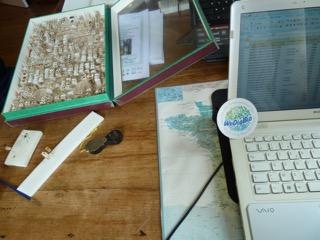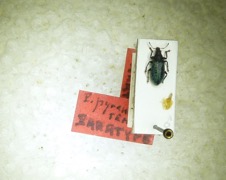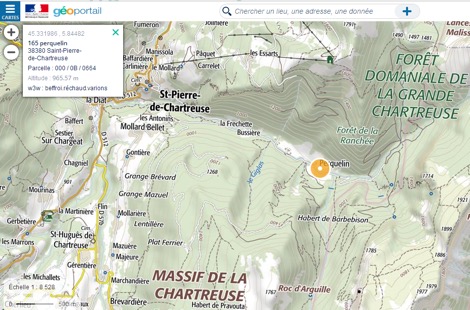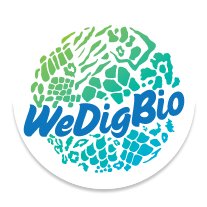
Contributed by Delphine Montagne and Patrick Weill
-So… Stasiodis parvulus, do you have it?
*tap tap tap*
-Yes I have, (Fabricius, 1792)
-Good. 3 pins.
*Tap-ti, tap-ti, tap-ti*
During this time, the 3 pins are outside the beetle box.
-It’s OK?
A happy smile is the answer.
-So. First pin. Two specimens, no sex, 1956, August, the third, Menton, Alpes Maritimes, observer: Pourtoy.
There is silence between words. The pace is adapted for the person who types on the computer. It is true that since September 2016, at the rate of two hours almost every Monday, including holidays, routines have formed.
Patrick takes every pin, one by one for all the species of the box. With a magnifying glass he reads the label's data and dictates the information before returning the pins to the beetle box. Delphine types on the computer. An operation repeated more than 4000 times. One for each pin.
They are both members of a naturalist association, the Entomology Group of the Western Pyrenees (GEPO)[1]. There is a forty-year-gap between Patrick, Palaearctic Weevil Specialist and Delphine, beginner entomologist. But both are sharing a common passion for "little animals".
"When I joined the GEPO, I asked how I could be helpful. Patrick offered to help digitize Mr Pourtoy’s beetle collection (a local entomologist who died in 1994)"
Many boxes of this collection are in a very bad condition. Many specimens were already destroyed by Anthrenus and humidity.
"A collection of entomological boxes, poorly preserved and unsupervised, can totally disappear in few years. Big specimens are the first to be attacked. Consequently all the work done and all the scientific data are lost for science. "
It is a race against time to digitize the rest of the collection. There are more than a hundred boxes of beetles from the Pyrenees, but also from the Massif Central and the French Riviera -- these data are unpublished. It contains paratypes. Most of them taking the name of Mr Pourtoy, like Otiorhynchus pourtoyi (a large weevil living above 2000 m in the Pyrenees). The two GEPO members began the job by digitizing the family of weevils, Patrick's specialty.

"I adapted an Excel spreadsheet with a list of all beetles derived from the reference taxonomic system in France (TAXREF[2] from French National Museum of Natural History) and a list of all the French cities issued from the IGN (National Institute of Geographic and Forest Information) referential. But this is not always enough. Some weevils are not listed in TAXREF and some place names are not catalogued by the IGN".
In the first case, Patrick looks in his large collection of entomological books to find the actual insect name: in the Catalog of French Coleoptera by M.Tronquet or The French Weevil monograph by A. Hoffmann. The synonym is indicated in one column of the Excel file and will be sent to the TAXREF staff in Paris. For localities, Delphine consults Geoportal[3], an IGN Website, to search the exact location and quote the geographical uncertainty.

"For example, for the" Grande Chartreuse, perquelin " (above), I search the place name, note the coordinates XY then find the accuracy of the location, here 10 meters minimum. "
No date, no locality, some data are sometimes incomplete. "Data lost to science. It is even more sad when they are uncommon species. "
It is a long task but also a time for knowledge transfer.
"Biology is not my job: I have a lot to learn in entomology. I enjoy listening to Patrick's anecdotes about entomologists, the name of an insect, technical vocabulary, a place name where he already made field trips ... Or... Inveigh against a poorly prepared specimen, insects too tight on their pins or illegible handwriting. I can also examine a marvellous or very specific insect using a magnifying glass. This is an incredible opportunity."
There are two weevil boxes remaining to be digitized, then the data will be sent to the INPN[4] (National Inventory of Natural Heritage), a website that summarizes all public data on French biodiversity: "for some insects, this will be the first data loaded in the INPN database! We will also write a paper together on the work already done. If accepted, it will be my first paper in a naturalistic publication. "
However, a lot of work remains to digitize the rest of the beetle boxes. But this first dataset dealing with Pourtoy’s Weevils, will soon be available for everybody. This data could be analyzed, taken into account in atlases, impact studies, or future red lists. These saved data could be transmitted by the INPN to the GBIF[5] (Global Biodiversity Information Facility), to regional French entities and in the near future open to a whole world access[6].
(We love to hear about and share stories like this. If you have one to share, please email us, wedigbio@gmail.com, to connect!)






